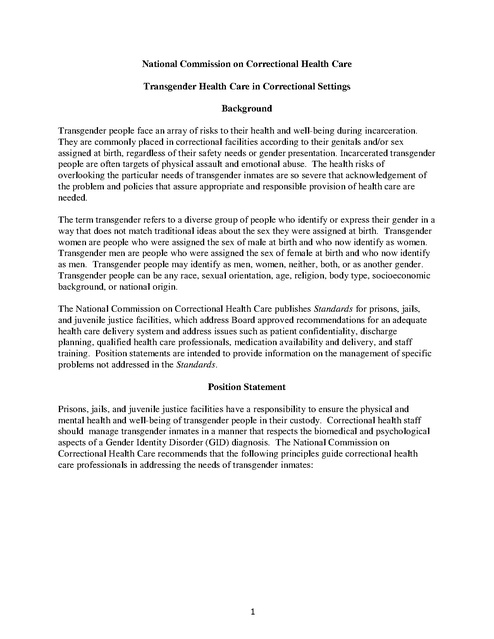National Commission on Correctional Health Care Transgender Health Care in Correctional Settings 2009
Download original document:

Document text

Document text
This text is machine-read, and may contain errors. Check the original document to verify accuracy.
National Commission on Correctional Health Care Transgender Health Care in Correctional Settings Background Transgender people face an array of risks to their health and well-being during incarceration. They are commonly placed in correctional facilities according to their genitals and/or sex assigned at birth, regardless of their safety needs or gender presentation. Incarcerated transgender people are often targets of physical assault and emotional abuse. The health risks of overlooking the particular needs of transgender inmates are so severe that acknowledgement of the problem and policies that assure appropriate and responsible provision of health care are needed. The term transgender refers to a diverse group of people who identify or express their gender in a way that does not match traditional ideas about the sex they were assigned at birth. Transgender women are people who were assigned the sex of male at birth and who now identify as women. Transgender men are people who were assigned the sex of female at birth and who now identify as men. Transgender people may identify as men, women, neither, both, or as another gender. Transgender people can be any race, sexual orientation, age, religion, body type, socioeconomic background, or national origin. The National Commission on Correctional Health Care publishes Standards for prisons, jails, and juvenile justice facilities, which address Board approved recommendations for an adequate health care delivery system and address issues such as patient confidentiality, discharge planning, qualified health care professionals, medication availability and delivery, and staff training. Position statements are intended to provide information on the management of specific problems not addressed in the Standards. Position Statement Prisons, jails, and juvenile justice facilities have a responsibility to ensure the physical and mental health and well-being of transgender people in their custody. Correctional health staff should manage transgender inmates in a manner that respects the biomedical and psychological aspects of a Gender Identity Disorder (GID) diagnosis. The National Commission on Correctional Health Care recommends that the following principles guide correctional health care professionals in addressing the needs of transgender inmates: 1 Transgender Health Care in Correctional Settings, Page 2 of 3 Management 1. The management of medical (e.g., medically necessary hormone treatment) and surgical (e.g., genital reconstruction) transgender issues should follow accepted standards1 that have been developed by professionals with expertise in transgender health. Determination of treatment necessary for transgender patients should be on a case-by-case basis. Ideally, correctional facility health professionals should be trained in transgender health care issues. Alternatively, correctional health staff should have access to other professionals with expertise in transgender health care to help determine appropriate management and provide training in transgender issues. 2. Because inmate-patients may be under different stages of care prior to incarceration, there should not be blanket administrative or policies that restrict specific medical treatments for transgender people. Policies that make treatments available only to those who received them prior to incarceration, or limit GID treatment to psychotherapy should be avoided. Policies that attempt to “freeze” gender transition at the stage reached prior to incarceration are inappropriate and out of step with medical standards, and should be avoided. 3. Diagnosed transgender patients who received hormone therapy prior to incarceration should have that therapy continued without interruption pending evaluation by a specialist, absent urgent medical reasons to the contrary. Transgender inmates who have not received hormone therapy prior to incarceration should be evaluated by a health care provider qualified in the area of transgender health to determine their treatment needs. When determined to be medically necessary for a particular inmate, hormone therapy should be initiated and sex reassignment surgery considered on a case-by-case basis. Regular laboratory monitoring should be conducted according to community medical standards. 4. Treatment for genital self-harm, and for complications arising from prior surgery or from forms of self-treatment, should be provided when medically necessary. 5. Correctional health care providers should provide patient education materials to help transgender patients cope with their diagnosis and treatment. 6. Psychotherapy such as “reparative” therapy or attempts to alter gender identity should not be employed. Reparative therapy inappropriately portrays GID as a mental illness and not a medical condition. Patient Safety 7. 1 In matters of housing, recreation, and work assignments custody staff should be aware The Standards of Care for Gender Identity Disorders by the World Professional Association for Transgender Health. Transgender Health Care in Correctional Settings, Page 3 of 3 that transgender people are common targets for violence. Accordingly, appropriate safety measures should be taken, regardless of whether the individual is placed in male or female housing areas. Discharge Planning 8. Transgender inmates receiving hormone therapy should receive a sufficient supply upon release to last until a community provider assumes care. Referrals should be made to community-based organizations with sensitive and inclusive services for transgender people. 9. Correctional policies for management of transgender inmates should be developed and implemented in partnership with local transgender communities, particularly current and former inmates, and transgender service providers, whenever possible. Adopted by the NCCHC Board of Directors October 18, 2009, Orlando, Florida.





